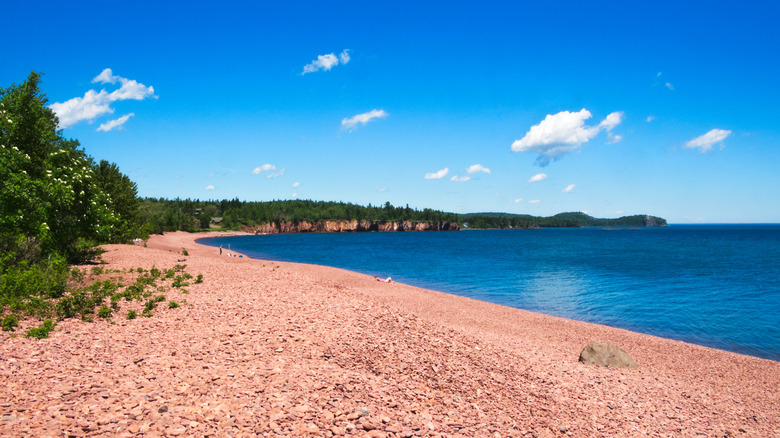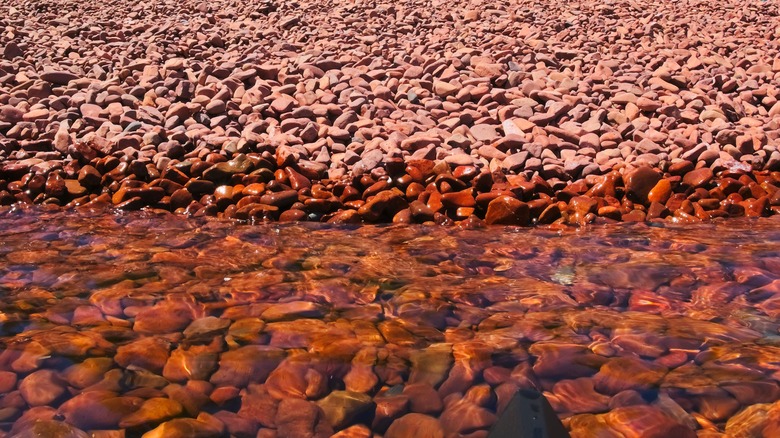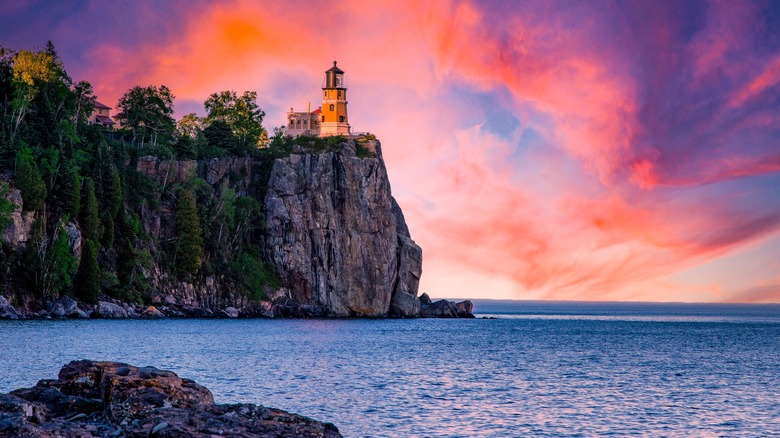This Little-Known Beach On Lake Superior's Shores Is A Unique Pink Getaway
When you think of pink beaches, tropical paradises like Horseshoe Bay in Bermuda or Elafonisi Beach in Crete might come to mind. What if we told you there is a Barbie-worthy pink beach in, of all places, Minnesota? Along the rugged northern shore of Lake Superior is a hidden pink-hued gem that few travelers have had the pleasure of discovering: Iona's Beach. This secluded stretch of shoreline in the "Land of 10,000 Lakes" is unlike any other in the Midwest region.
Iona's Beach offers a rare and surprising alternative to the rest of the gray rocky shoreline of Lake Superior, the largest of the five Great Lakes — a massive body of freshwater that feels more like an ocean than a lake. Located within the Iona's Beach Scientific and Natural Area, this enchanting beach goes for 300 yards along the lake. What makes Iona's Beach truly unique is its salmon-colored shoreline, which is composed not of sand but of smooth, wave-washed pebbles ranging in color from soft pink to reddish-brown.
If that isn't remarkable enough, there's more: If you know when and how to listen, the stones at Iona's Beach sing. As waves crash against the shore, the pink rocks are pushed together, creating a distinctively musical clinking sound, like a concert of little bells. The chime-like melody at this "singing beach" is usually heard on a day that isn't too windy, and when the waves aren't too still — you have to be there at the right time.
Iona's Beach: A pink geological wonder
The rocks at Iona's Beach were formed during a period of intense volcanic activity known as the Midcontinental Rift. Lava flows emerged from the Earth's mantle and created the basalt and rhyolite geological formations that now line the shores of Lake Superior. Over the years, the relentless waves of the lake have eroded the rhyolite into small, rounded stones polished to perfection by the water. The pink hue of the stones comes from the high concentration of feldspar minerals within the rhyolite, which gives the beach its unique coloration. The source is found near the north of the beach: a 30-foot high cliff made of pink rhyolite and felsite bedrock.
Iona's Beach isn't just a pretty sight; it's also a protected area, designated as a Scientific and Natural Area (SNA) by the Minnesota Department of Natural Resources. This designation helps preserve the beach's beauty and geological significance. Because of this — as tempting as it may be — visitors are not allowed to collect the pink stones or any plants, animals, and fossils. Entrance to Iona's Beach is free. You'll find that on most days, there's less than a handful of people there — perfect for a zen, quiet escape into nature. Walk along the beach, spot one of 20+ species of warblers, swim in the water, explore the aspen-birch forest behind the beach, bring your camera (and keep your gear safe with this unexpected baby product), or partake in shore fishing; there's much to do.
More exploration nearby
To get to Iona's Beach, drive down MN Highway 61, park in the upper lot of Twin Points Access, and then follow signage along the Gitchi Gami State Trail to the beach; the hike from the lot to Iona's is only a couple hundred feet. Now, while Iona's Beach is a destination in and of itself — you could easily spend hours gazing at the water and hearing the rocks chime — it's also a great starting point for exploring the broader region. The North Shore of Lake Superior is known for its natural beauty, with many parks, hiking trails, and scenic overlooks to discover. There's also an underrated city you can visit for a relaxing getaway just under an hour away.
Just a short drive from Iona's Beach, you'll find Split Rock Lighthouse State Park, home to the iconic Split Rock Lighthouse. This historic lighthouse, perched atop a "looks like it's going to fall" 130-foot rock cliff, was built in 1910 after 29 ships were tragically destroyed by the Mataafa Storm in 1905. In 1969, the lighthouse ceased to be a beacon for sailors of the lake because of modern technology. You can get tickets and schedule a tour of the lighthouse. Further north, you can explore Tettegouche State Park — the largest Minnesota state park along Lake Superior's shoreline — where you'll find waterfalls (like High Falls on the Baptism River, the tallest waterfall in Minnesota), dense forests, and seemingly endless water sports, like kayaking.


